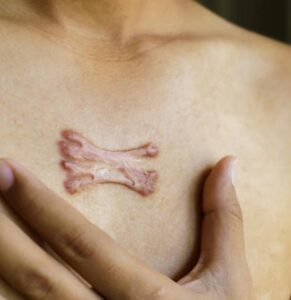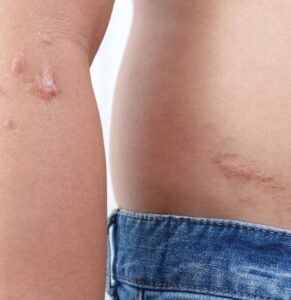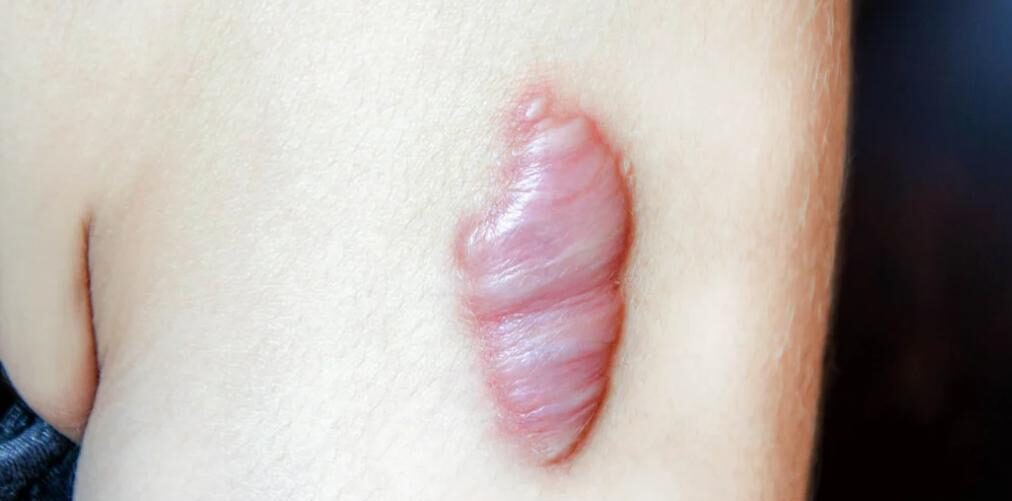Keloid & Hypertrophic Scar
Faramarz Rafie M.D. / Vancoderm Academy (VDA) / Vancoderm Clinic VDCmed.com)
At Vancoderm Academy, we prepare our students to make safe, ethical, and informed decisions in their aesthetic practice. A critical part of this is understanding how to assess and manage abnormal scarring, particularly keloids and hypertrophic scars, which are contraindications for many cosmetic procedures.
Definition of Keloids and Hypertrophic Scars
Keloids and hypertrophic scars are both the result of abnormal wound healing. However, they differ in behavior, appearance, and treatment approach.
Hypertrophic scars are thickened, raised scars that remain confined to the boundary of the original wound. They often appear red or pink and may improve over time. These scars commonly result from delayed healing, excessive tension on the wound, or infection.
Keloids, on the other hand, are more aggressive. They grow beyond the boundaries of the original injury, and may continue to expand over time. Keloids tend to be shiny, rubbery, and discolored, often presenting in red, brown, or purple tones depending on the individual’s skin type. They are more common in people with darker skin and can develop from any trauma, including minor injuries, piercings, acne, or surgery.
Pathophysiology: Collagen Overproduction
When the skin is injured, the body initiates a complex healing process that includes inflammation, tissue regeneration, and remodeling. Fibroblasts, a type of skin cell, are responsible for producing collagen, which provides structural support to the skin during this process.
In normal wound healing, collagen production is balanced and stops once the wound is repaired. However:
-
In hypertrophic scars, fibroblasts become overactive and produce too much collagen (primarily Type III collagen initially), but the scar remains confined to the original wound area. These scars may improve or flatten over time.
-
In keloids, collagen production is not only excessive but also uncontrolled, continuing even after the wound has healed. This results in a thick, raised scar that extends beyond the wound margins. Keloids are rich in both Type I and Type III collagen, arranged in a disorganized, whorled pattern.
Etiology of Keloid and Hypertrophic Scars
Both keloid and hypertrophic scars result from abnormal wound healing, specifically due to an imbalance in collagen production during the remodeling phase of tissue repair. The key differences lie in the extent of the scarring and the body’s response to injury.
 Keloid Scars
Keloid ScarsEtiology:
-
Caused by excessive and prolonged collagen synthesis, particularly Type I and Type III collagen, after skin injury.
-
The scar tissue extends beyond the original wound borders and does not regress over time.
-
Associated with genetic predisposition, especially in individuals with darker skin tones (Fitzpatrick types IV–VI).
-
Common triggers include surgical incisions, acne, piercings, burns, vaccinations, and even minor trauma such as insect bites.
-
Dysregulation of fibroblast activity and certain growth factors (such as TGF-β) plays a central role in the persistent overproduction of extracellular matrix components.
-
Performing invasive procedures (e.g., Microneedling, laser, surgery, extractions) while on or shortly after Accutane can increase the risk of hypertrophic or keloid scarring, especially in people already predisposed to such scars.
-
This is why most Dermatologists, and Medical Aestheticians recommend waiting 6 to 12 months after stopping Accutane before undergoing aesthetic treatments involving dermal injury.
Hypertrophic Scars

Etiology:
-
Result from an overactive wound healing response, where collagen production exceeds degradation but remains confined within the original wound boundaries.
-
Often associated with excessive tension on a healing wound, infection, prolonged inflammation, or delayed wound closure.
-
Primarily involves increased Type III collagen arranged in a parallel pattern.
-
More likely to appear within weeks after injury and may gradually improve or flatten over time.
In summary, both scar types arise from exaggerated fibroblast activity and abnormal collagen remodeling, but keloids are more aggressive, genetically influenced, and extend beyond the wound site, while hypertrophic scars are more common and often self-limiting.
-
Why Keloids and Hypertrophic Scars Are Contraindications in Medical Aesthetics
Treating clients with a history of keloid or hypertrophic scarring carries significant risks. One of the main concerns is the Koebner phenomenon, also known as the isomorphic response. This refers to the tendency for new lesions or abnormal scars to form at sites of trauma. Even minimal skin injury can trigger keloid or hypertrophic scar formation in susceptible individuals.
Many common medical aesthetic procedures involve controlled injury to the skin. This includes but not limited to Microneedling, Laser Resurfacing, Dermal Fillers, Neuromodulator Injection, Radiofrequency Microneedling, and medium to deep Chemical Peels. In clients prone to abnormal scarring, these treatments may not only be ineffective but can result in worsened skin conditions, increased scarring, and psychological distress.
The healing process in such clients is unpredictable. What may be a minor, temporary inflammation in the general population can lead to long-term raised scarring or thickened tissue in those predisposed to keloids or hypertrophic scars. This risk makes them unsuitable candidates for invasive cosmetic procedures unless under strict medical supervision.
What Aesthetic Professionals Should Do
A thorough client consultation and assessment is essential before initiating any treatment. Clients should be asked about previous scarring experiences, surgical history, acne scars, piercings, and wound healing. If there is any indication of keloid or hypertrophic scarring, invasive treatments should be avoided.
In these cases, non-invasive or minimal-contact treatments can be considered. These may include LED therapy, gentle topical skin care, or soothing facials without exfoliation. Any treatment decision must be made with full disclosure and informed consent, and it is often best to refer the client to a dermatologist for further evaluation.
How Keloids and Hypertrophic Scars Are Treated
Treating hypertrophic scars may involve silicone gels or sheets, corticosteroid injections, and sometimes pressure therapy. These scars have a better prognosis and may improve with time.
How Keloids and Hypertrophic Scars Are Treated
The treatment of keloids and hypertrophic scars often requires a combination of therapeutic approaches, tailored to the severity, location, and response to past treatments. These scars can be challenging to manage and may require several sessions over an extended period.
For hypertrophic scars, many cases improve gradually over time, especially with proper wound care and early intervention. When intervention is necessary, common treatment options include silicone-based products (such as gels or sheets) to help soften and flatten the scar, as well as corticosteroid injections to reduce inflammation and limit collagen buildup.
Keloids, which are more aggressive and tend to grow beyond the initial injury site, require more targeted treatment. One of the most effective first-line options is intralesional corticosteroid injections, typically using triamcinolone. These injections help reduce inflammation, suppress collagen production, and flatten the scar over time. Treatment often requires multiple sessions spaced several weeks apart.
In addition to corticosteroids, vascular lasers such as the pulsed dye laser (PDL), specifically the Vbeam laser, have shown clinical benefit in reducing redness, improving texture, and softening both keloids and hypertrophic scars. The Vbeam laser targets hemoglobin within the scar tissue, leading to a reduction in vascularity and associated symptoms such as itching or tenderness. While laser treatment alone may not eliminate a keloid, it can be highly effective when used in combination with other modalities like corticosteroid therapy.
For more resistant or recurrent cases, adjunct treatments may include cryotherapy, 5-fluorouracil (5-FU) injections, or in rare cases, surgical excision followed by radiation or medical therapy to prevent recurrence.
It is important to note that even with treatment, keloids may return. Management is often long-term and may require ongoing care under medical supervision.
Conclusion
Understanding keloids and hypertrophic scars is critical for anyone entering the field of medical aesthetics. These conditions are more than cosmetic concerns—they are complex wound-healing disorders that require cautious management. In the aesthetic practice, recognizing these contraindications not only protects the client but also upholds professional integrity. When in doubt, always consult or refer to a dermatologist. At Vancoderm Academy, we teach our students to prioritize safety, make informed clinical decisions, and practice within ethical boundaries.
Thank you for taking the time to read and stay informed through Vancoderm Academy’s educational blogs. We invite you to follow us regularly for more insights into clinical skin science and safe medical aesthetic practices.

